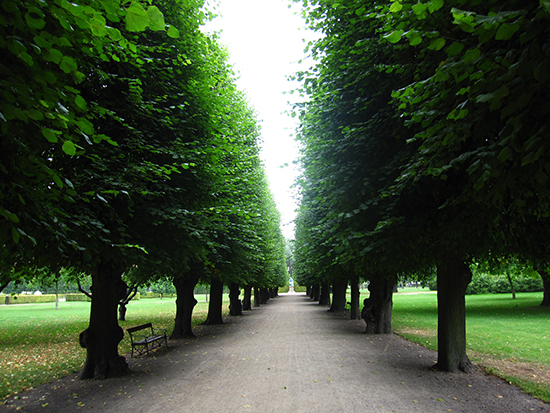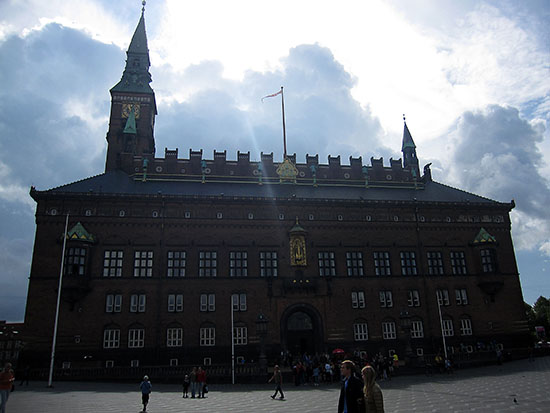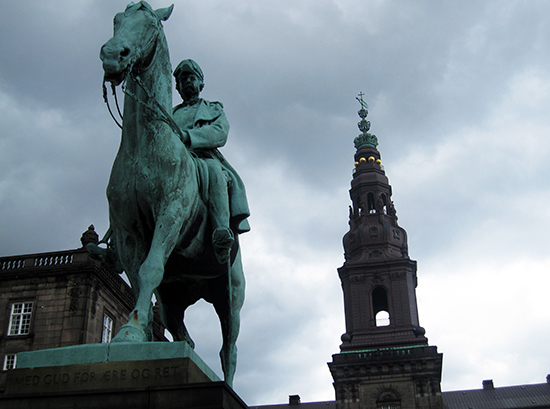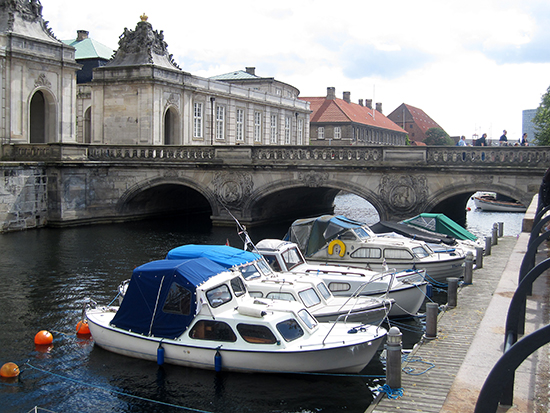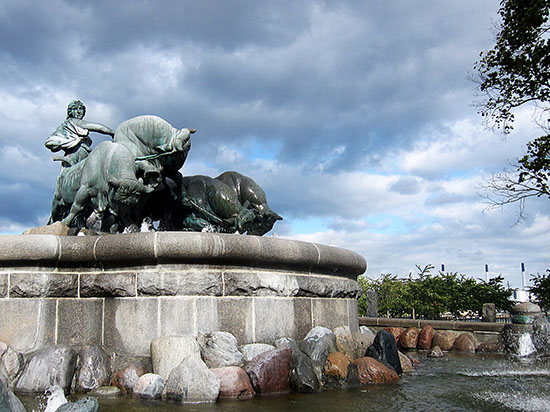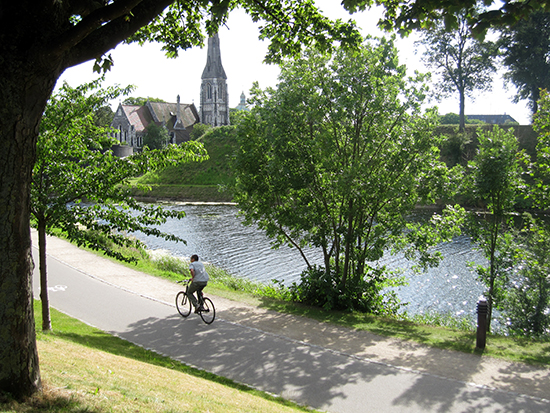Oh Copenhagen! What a stunner, I love, love, love this city!
I arrived by train directly over the bridge from Sweden and walked from Central Station to the Generator Hostel – which I highly recommend, it’s clean and friendly with all the optional extras you could need.
After dropping off my stuff, I had a few hours of daylight to take a quick peek around the neighborhood. There’s a beautiful park right around the corner, Kongens Have (the literal translation is The Kings Garden but it’s also known as Rosenborg Castle Gardens). It’s the most visited park in Copenhagen as well as the oldest, having been established in the early 17th century.
I came for a walk here every morning of my stay, the tree lined paths are so dreamy, perfect for a wander and a ponder :-)
I also took a liking to this giant statue of Queen Caroline – so foreboding! I’m not sure what type of Queen she was, but the statue sure has presence.
The gardens inside the park were established in the Renaissance style by Christian IV in the early 1600’s – wow! That actually blows my mind; something tenderly brought to life and curated by a gardener vastly outlives its creator – by centuries! Nature is so humbling.
My favorite way to first explore a new place is hitting the streets, and the good thing about quality hostels is that they usually run or can connect you with a walking tour. My first morning in Copenhagen I joined a three hour free walking tour run by Sandalmans. They’re a worldwide organisation that facilitates free walking tours where people with vast local knowledge and a flair for communicating that knowledge can lead groups of tourists around their city. There is no fee or obligation to pay for the tour, however the tour leader is volunteering their time, so the idea is that you tip them what it was worth to you. My group was lead by a young, upbeat woman who definitely knew her Copenhagen. We walked all over with plenty of time for photo stops, stories and a refreshment break.
The tour started at Rådhuspladsen (City Hall Square).
These freaky gargoyle dragons were made for the nearby Dragon Fountain in 1904, based on a sketch drawn in 1889. They ended up being quite a bit larger than the original sketch so eventually smaller dragons were made and these big ones were relocated in front of City Hall.
Also located in the square is Lurblæserne (The Lur Blowers), a famous statue. They have been there since 1911, when they were gifted by the Carlsberg Foundation to celebrate the 100 year birthday of the brewer JC Jacobsen. There is a legend that says the two vikings blow a sound on their trumpets (lurs) whenever a virgin passes by!
We started walking from here; we saw so much I couldn’t possible recall everything. Some standouts include:
Christiansborg Palace, where a statue of King Christian IX sits in the square out the front. The palace is the only building in the world that houses all three of a country’s branches of government (cool fun fact).
We walked by Nybrogade, a pretty canal with beautiful historic houses running alongside. The canal is so narrow, it was fun to watch the long passenger boats performing twenty-point turns in the corners to get through!
We watched the changing of the guard at Amalienborg Palace, where the Queen and her family live. Aussie born Princess Mary and her husband Prince Frederik live next door with their children.
This pretty cluster of buildings is in Copenhagen Nytorv (New Square) with the Court House on the right.
There’s those famous coloured building rows!
I also did a canal cruise with Sandemans which is an awesome way to see Copenhagen from another vantage point. Across the water here is Salt, a famous Copenhagen restaurant located in a refurbished 18th century corn warehouse. It is very pricey and a bit posh – I did not go there (this time!)
We got off at wharves along the way to see some sights.
Gefion Fountain is really striking, it’s another donated gift given to the city of Copenhagen by the Carlsberg Foundation, this time for the Carlsberg brewery’s 50 year anniversary in 1897.
I enjoyed the story our tour guide shared with us – Gefion was a Goddess in Norse mythology who was offered as much land in Sweden as she was able to plough during one day and night by the Swedish King Gylfe. To maximize her results she turned her four sons into strong oxen. Gefion and the oxen ploughed the land that is Zealand the Island where Copenhagen is situated. This left a huge hole in Sweden where Lake Vänern is placed. On a map the outline of Zealand matches the outline of Lake Vänern! So obviously it’s true.
The Little Mermaid is also a famous statue in Copenhagen although quite unassuming once you see it. It’s small but graceful and has a colorful history which explains its fame.
It is yet another gift from Danish brewer Carl Jacobsen to the City of Copenhagen, installed in 1913.
The sculpture is made of bronze and granite and was inspired by Copenhagener Hans Christian Andersen’s fairy tale about a mermaid who falls in love with a handsome prince on land.
Carl Jacobsen fell in love with the character after watching a 1909 ballet performance based on the fairy tale at the Royal Danish Theatre in Copenhagen. He commissioned the sculptor Edvard Eriksen to create the mermaid in the likeness of ballerina Ellen Price, who danced the lead role in the ballet.
Ellen wouldn’t model in the nude for sculptor Edvard Eriksen so although the mermaid’s face is modeled on the ballerina’s, Eriksen’s wife posed for the body.
The sculpture has been vandalised a number of times – she has lost her head, her arm, and had paint poured on her more than once! Copenhageners are quite protective of her though, so each time she has been patched up.
This beautiful church is called St Albans Church, known as ‘the English Church’. It was built between 1885-1887.
Copenhagen is such a pretty city, so many photo-worthy shots at every turn.
The tour also took us over to Christiania, which is a self-proclaimed autonomous community living in a collectively shared and controlled village. It was founded in 1971, when a group of people cut a hole in the fence of an unused military barracks. Soon the area was known for it’s Pusher Street, where you could buy hash and pot.
Today around 1,000 people live there, many of them the original settlers. The population numbers are capped, if you grew up there or marry into a family you get preference. Every year more than 500,000 people come to visit, though there are quite a lot of rules to adhere to such as no hard drugs, photography, talking on the phone or running (apparently it alarms people that cops are there!)
It was interesting to take a walk there but it felt a bit awkward to be honest. I mean, it’s a neighborhood not a tourist attraction! And I think I did get a bit high just walking down Pusher St and breathing at the same time.
And that concluded our tour. I highly recommend the Sandamans free walking tour if you’re in Copenhagen, I would not have learnt as much as I did about each site if I had wandered around on my own.
Latest posts by Donna (see all)
- Kosciuszko Full Moon Adventure - April 29, 2018
- Camping Getaway at Chichester State Park - September 2, 2017
- Moutain Bike Riding Down Mt Lofty - January 27, 2017
